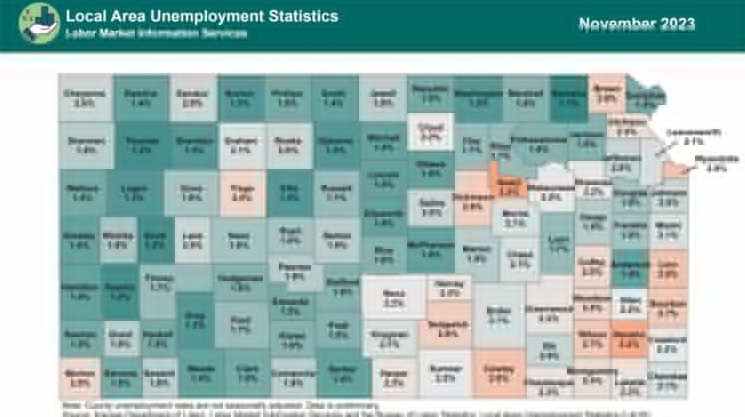The unemployment rate in Kansas stayed at 2.9% in November, matching the rate from one year ago, according to the latest report from the Kansas Department of Labor and the Bureau of Labor Statistics. This indicates that the state’s labor market has recovered from the impact of the COVID-19 pandemic, which pushed the unemployment rate to a record high of 11.9% in April 2020.
Kansas Outperforms National Average
The unemployment rate in Kansas is lower than the national average, which was 4.2% in November, down from 4.6% in October. Kansas is one of the 17 states that have an unemployment rate below 3%, and ranks 10th among the states with the lowest unemployment rate. The state with the lowest unemployment rate is Nebraska, with 1.9%, while the state with the highest unemployment rate is Nevada, with 7.5%.
The unemployment rate measures the percentage of people who are actively looking for work but cannot find a job. It does not include people who are not in the labor force, such as those who are retired, students, homemakers, or discouraged workers. The labor force participation rate, which measures the percentage of people who are either working or looking for work, was 66.4% in Kansas in November, slightly higher than the national average of 61.8%.
Kansas Adds Jobs Across Sectors
The state of Kansas added 3,500 nonfarm jobs in November, an increase of 0.2% from October. The private sector added 4,000 jobs, while the government sector lost 500 jobs. Over the year, the state gained 48,600 nonfarm jobs, an increase of 3.5% from November 2020. The private sector added 47,200 jobs, while the government sector added 1,400 jobs.

The sectors that added the most jobs over the month were education and health services (+1,800), trade, transportation, and utilities (+1,300), and professional and business services (+1,000). The sectors that lost the most jobs over the month were leisure and hospitality (-1,000), construction (-600), and information (-200).
The sectors that added the most jobs over the year were leisure and hospitality (+15,900), trade, transportation, and utilities (+10,700), and professional and business services (+8,600). The sectors that lost the most jobs over the year were mining and logging (-300), information (-200), and financial activities (-100).
Kansas Wages and Inflation Rise
The average hourly earnings of private sector employees in Kansas increased by 8 cents to $25.97 in November, up 5.9% from a year ago. The average weekly hours of private sector employees in Kansas decreased by 0.1 hour to 34.4 hours in November, down 0.6% from a year ago. The average weekly earnings of private sector employees in Kansas increased by $2.68 to $893.38 in November, up 5.3% from a year ago.
The inflation rate in Kansas, measured by the Consumer Price Index (CPI), increased by 0.8% in November, up 6.8% from a year ago. The CPI measures the changes in the prices of a basket of goods and services that are typically purchased by consumers. The main factors that contributed to the rise in inflation in Kansas were transportation (+2.1%), food (+1.1%), and housing (+0.8%). The main factors that moderated the rise in inflation in Kansas were apparel (-1.5%), recreation (-0.4%), and education and communication (-0.1%).
The inflation rate in Kansas is higher than the national average, which was 0.8% in November, up 6.8% from a year ago. The main factors that contributed to the rise in inflation in the U.S. were energy (+3.5%), transportation (+1.4%), and food (+0.8%). The main factors that moderated the rise in inflation in the U.S. were apparel (-0.8%), education and communication (-0.2%), and medical care (+0.1%).

Comments